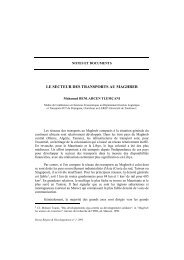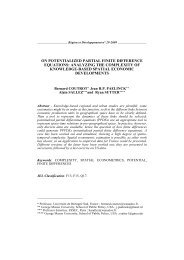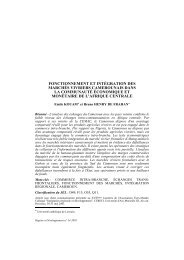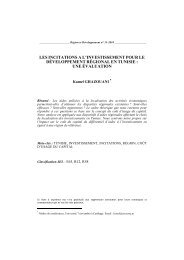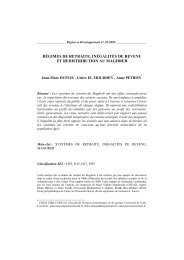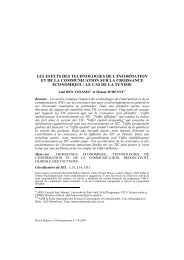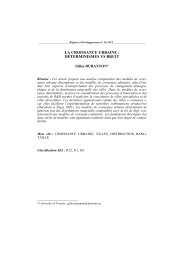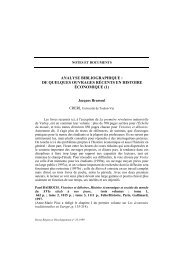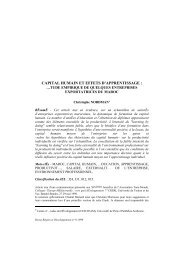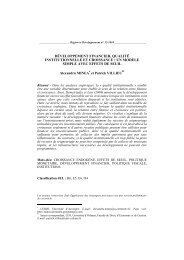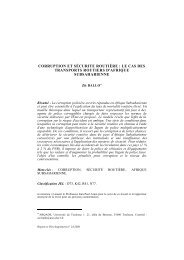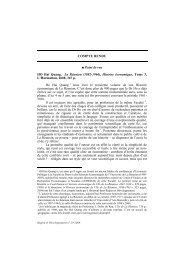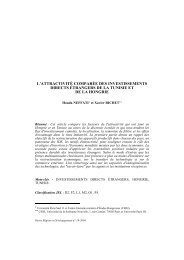space and growth: a survey of empirical evidence ... - ResearchGate
space and growth: a survey of empirical evidence ... - ResearchGate
space and growth: a survey of empirical evidence ... - ResearchGate
You also want an ePaper? Increase the reach of your titles
YUMPU automatically turns print PDFs into web optimized ePapers that Google loves.
22 Maria Abreu, Henri L.F. de Groot <strong>and</strong> Raymond J.G.M. Floraxtheory or policy considerations). Of these studies, 11% use spatial data analysistechniques, 6% use a spatial lag model, 29% estimate a combination <strong>of</strong> thespatial error, spatial lag, spatial cross-regressive <strong>and</strong> spatial regimes models,11% look at Markov transition matrices, <strong>and</strong> 6% use other more unusual types <strong>of</strong>models. The distribution <strong>of</strong> the remaining studies by type <strong>of</strong> channel is almostevenly split among four categories: 8% <strong>of</strong> the studies have focused on spatialheterogeneity, 11% on technology diffusion, 10% on spatial spillovers <strong>and</strong> 8%on spatial convergence clubs. The statistics also indicate that 8% <strong>of</strong> the studiesare based on models <strong>of</strong> absolute location, <strong>and</strong> 92% on models <strong>of</strong> relativelocation. Only 11% <strong>of</strong> all studies derive their <strong>empirical</strong> models explicitly fromtheory.All <strong>of</strong> the studies based on absolute location use a spatial regimes model toinvestigate spatial heterogeneity. Most <strong>of</strong> them also touch on spatial dependence,either by using exploratory spatial data analysis techniques to identify clusters,testing the residuals for autocorrelation, or estimating a spatial regimes modelthat also allows for spatial dependence. One <strong>of</strong> the advantages <strong>of</strong> using spatialeconometrics to estimate models <strong>of</strong> spatial heterogeneity resides in thepossibility <strong>of</strong> testing for any remaining spatial autocorrelation, since ignoring itcould result in biased coefficients. Another advantage <strong>of</strong> using spatialeconometrics is that exploratory spatial data techniques can help with theidentification <strong>of</strong> the spatial regimes. For example, Roberts (2004) estimates anabsolute convergence model using county-level data for the United Kingdom. Hefinds no <strong>evidence</strong> <strong>of</strong> convergence, <strong>and</strong> a test for parameter stability across thetraditional North-South divide is inconclusive. An exploratory spatial dataanalysis reveals a cluster <strong>of</strong> counties in the South West with low initial levels <strong>of</strong>GDP per capita. A spatial regimes model based on a structural break between theSouth West counties <strong>and</strong> the rest <strong>of</strong> the UK shows that while the rest <strong>of</strong> the UKis converging in terms <strong>of</strong> per-capita income, the South West is diverging.Table n° 2: Spatial econometric studiesStudyChannelsTheoretical Geographical Spatialbackground scope weightsArmstrong (1995) 5 CO B W1Ades <strong>and</strong> Chua (1997) 3 S A W1Moreno <strong>and</strong> Trehan (1997) 5 S A W3Easterly <strong>and</strong> Levine (1998) 3 S A W1Fingleton et al. (1998) 2 O B W3Vayá et al. (1998) 5 C-P B W1Fingleton (1999) 5 CO B W3López-Bazo et al. (1999) 5 NN B W1Rey <strong>and</strong> Montouri (1999) 5 U C W1Aroca <strong>and</strong> Bosch (2000) 5 U D W1Attfield et al. (2000) 5 CO F W3Baumont et al. (2000) 5 U B W4Cannon et al. (2000) 1 O B W5Fingleton (2000)* 2 O A W3Vayá et al. (2000)* 2 S B W5Ying (2000) 5 C-P E W3




